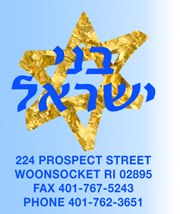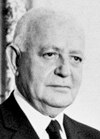Congregation B’nai Israel History


The first recorded fund-raiser by the Hebrew Ladies Aid Society/Sisterhood was a rummage sale held in 1910 at Nugent’s Stable on Social Street. It realized a grand total of $150, a goodly sum for those days. A gala ball also become an annual event for the women. To maximize their profits, they prepared all the refreshments, made the decorations, checked coats, and sold raffle tickets. The beneficiaries of their efforts were always the synagogue and the Hebrew school. Later, a separate organization, the Woonsocket Communal Fund (name later changed to the Woonsocket Hebrew Community Center), an offshoot of the society, devoted itself strictly to raising funds for the religious school and for a community center.
In 1914, two more organizations were added to the growing community roster: the Young Men’s Hebrew Association and the Young Women’s Hebrew Association. Basically social organizations, they also took on educational and cultural programs as well as fund-raising activities on behalf of the Jewish Relief Fund. The young men had a particular talent for debating. Indeed, the Woonsocket team attracted accolades as they went about their winning style of debating during the fifteen years of their existence. The congregation prospered in its home in the former Presbyterian Church at Greene and Bernon Streets, holding services under the direction of a hazzan who also doubled as a shohet (ritual slaughterer), a lay reader who had the education and the scholarship to lead the prayers and, on occasion, to give a sermon or explanation of the Torah text in Yiddish. However, many of the younger members felt that the time had come to consider hiring a rabbi and to modernize the strictly orthodox service in ways they found more compatible. The appointment of Rabbi Abel Hirsh, an English-speaking Orthodox rabbi, in 1917 marked the beginning of the coming evolution of B’nai Israel to the Conservative ritual, although it remained Orthodox for the time being. The evolution was not necessarily peaceful, but an accommodation was ultimately reached that preserved unity.
the nearby villages of Harrlsville, Chepachet, Pascoag, Slatersville. Forestdale, or went door-to-door in the city itself, offering their goods or taking orders for merchants with establIshed stores. By dint of long hours and ingenuity, the peddler could earn enough to support his family and perhaps even to open a small shop after a time, which many did. Even into the mid-twentieth century, one congregant was still traveling the streets in horsedrawn wagon buying and selling rags.

Basically, then, one may say that these founding fathers and mothers were hard-working, industrious in the pursuit of the American dream for themselves, but especially for their children. They had a strong sense of community that transcended narrow bounds. It was inclusive, not exclusive.
However, it was a well-established fact, even back a century, that one cannot support a shul on dues and devotion alone, as the founders of Congregation Lovers and Peace discovered. Evidently the theater was in their blood, for they chose for their first fund-raising event a comic opera entitled “Esther.” It proved to be a major social and financial success and foreshadowed many theatrical productions that raised funds for the shul in later years.





Color photographs by Robert Golden